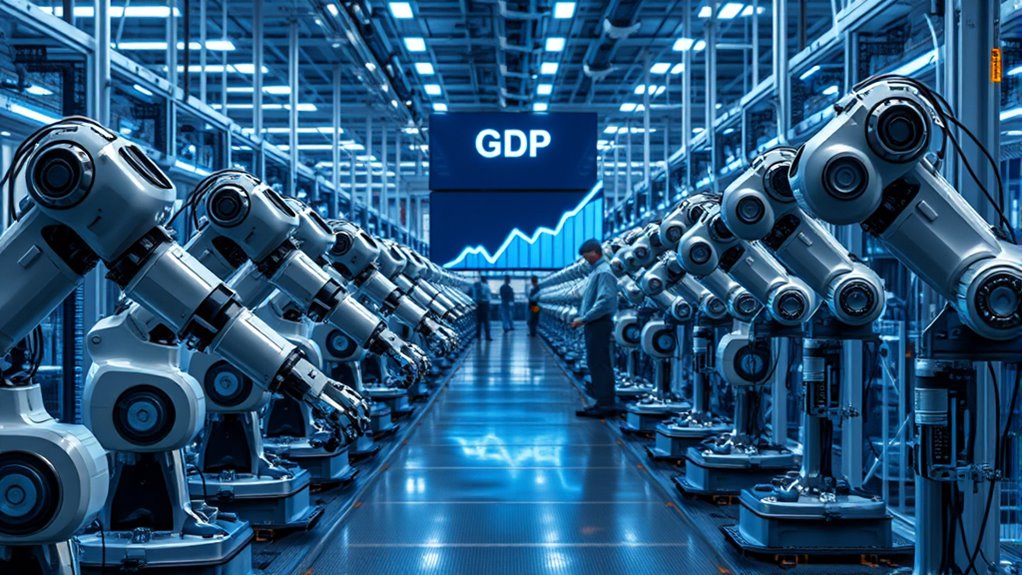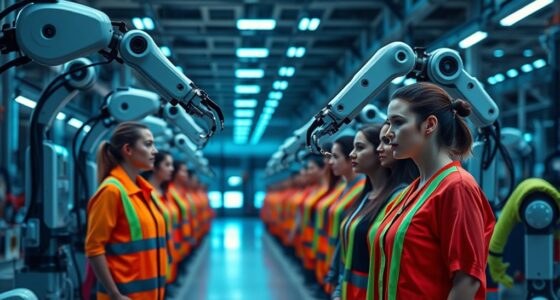You might worry that up to 40% of jobs could disappear due to automation and industry shifts, but the economy still shows signs of growth. Experts suggest that while many roles, especially routine and entry-level jobs, are at risk, sectors like care, tech, and clean energy are expanding. notably, global GDP is expected to keep climbing despite job cuts. If you want to understand how workplaces are transforming and what future opportunities look like, there’s more to explore.
Key Takeaways
- Economists forecast up to 40% global job reductions due to automation and technological shifts by 2025.
- Despite job cuts, global GDP is expected to grow modestly around 2.8%, driven by innovation and sectoral shifts.
- Automation replaces routine roles, leading to significant displacement, especially in retail, clerical, and manufacturing sectors.
- Growth sectors like technology, care, and education will create new jobs, partially offsetting layoffs.
- Reskilling and digital transformation are critical for workforce adaptation amid evolving employment landscapes.
Current Job Market Forecasts and Trends

The current job market is experiencing notable shifts driven by global economic uncertainties and geopolitical tensions. The International Labour Organization predicts a reduction of up to 7 million jobs in 2025, with the global employment growth rate dropping to 1.5%. Global GDP growth slows to 2.8%, impacting job creation worldwide. Jobs linked to U.S. consumer demand are at risk, especially in the Asia-Pacific region, which depends heavily on trade. In the U.S., job growth is expected to slow, with monthly gains decreasing and the unemployment rate rising to 4.5% by early 2026. These trends reflect a challenging landscape influenced by trade disruptions, economic slowdown, and shifting immigration policies, all contributing to the uncertain outlook for employment prospects globally. Notably, some industrial-inspired designs are experiencing a resurgence as markets seek to blend vintage aesthetics with modern innovations, signaling resilience in certain sectors despite broader economic challenges.
Structural Shifts in Employment From 2025 to 2030

Between 2025 and 2030, the global employment landscape will undergo significant structural changes, with roughly 22% of current jobs affected by transformation. You’ll see about 14% of roles created and 8% displaced, impacting sectors differently. Jobs like farmworkers, delivery drivers, and care workers will grow rapidly, while clerical and administrative roles, such as cashiers and secretaries, decline sharply. Skills like AI, cybersecurity, and creative thinking become essential, yet 39% of current skills will be outdated by 2030. The workforce must adapt quickly, but gaps persist. For instance, the rising importance of digital literacy reflects the ongoing integration of technology in everyday work. Additionally, the development of automation technologies is expected to further accelerate job shifts. Here’s a closer look at sectoral shifts:
| Sector | Growth/Decline | Key Drivers |
|---|---|---|
| Technology & Green | Rapid growth | Innovation, sustainability |
| Care & Education | Steady increase | Demographics, demand |
| Routine Roles | Sharp decline | Automation, digitization |
| Low-skill Jobs | Significant drop | Market polarization |
Technological Innovation and Automation’s Role in Job Displacement

You’ll notice automation replacing many human roles across industries, especially in routine and entry-level jobs. While some new tech roles emerge, they require higher skills, forcing workers to adapt quickly. This shift demands a focus on reskilling to stay relevant in an increasingly automated workplace. Immediate action is crucial, as over 76,000 jobs have already been lost to AI automation this year alone, highlighting the urgency of proactive adaptation. Additionally, understanding the contrast ratio used in projectors can be analogous to recognizing the differences in job displacement impacts across sectors, emphasizing the importance of clear metrics in evaluating technological effects.
Automation Replacing Human Roles
Technological innovation has considerably accelerated automation’s role in transforming workplaces, leading to widespread job displacement across industries. You’ll notice that 41% of global employers plan to cut their workforce within five years, with aggressive reductions already happening in 2025. An estimated 92 million jobs worldwide could vanish due to AI automation, and nearly half of U.S. workers are at risk. Sectors like retail face a 65% automation forecast by 2025, while manufacturing and tech companies have already laid off thousands, including roles in software and HR. Companies are adopting AI rapidly—90% of U.S. firms now use it, with 30% replacing human workers. This shift toward full automation is reshaping employment, with entire functions, not just costs, being replaced, impacting job availability and social mobility. Automation’s economic impact could affect half of the world economy, leading to significant shifts in labor markets and income distribution. Additionally, the rapid pace of technological change is making it difficult for workers to adapt and retrain for new roles.
New Tech Job Opportunities
Despite widespread job displacement caused by automation, the tech industry continues to generate new opportunities at a remarkable pace. In early 2025, employers added 228,000 new tech roles, with over 7 million job postings—up 33% month-over-month and 16% from last year. Companies are aggressively hiring AI and data science specialists, with more than 40,000 active postings requiring AI skills. Despite layoffs at some big firms, net job postings still increased by 51,000 in January. Regions like California, Illinois, and Georgia, especially San Jose and San Francisco, experience significant growth. Roles in AI, machine learning, blockchain, and cybersecurity dominate hiring, creating new positions such as prompt engineers and AI risk auditors. These shifts reflect a transformation, not a decline, in tech employment. Additionally, the ongoing technological innovation continues to reshape the job market, opening new avenues for professionals across various fields.
Skills Shift Necessities
As automation and AI become more integrated into industries, the demand for new skills accelerates while traditional roles face rapid displacement. You’ll need to adapt quickly, as 92 million jobs could be displaced by 2025. Many companies are automating tasks, with 40% planning workforce reductions and 30% replacing workers with AI tools. This shift affects sectors like manufacturing and retail, risking significant job losses—up to 65% of retail roles might vanish. To stay relevant, you’ll need to develop new skills, as 60% of jobs will undergo task-level changes. Education and training programs become essential, but AI may also limit entry-level opportunities, impacting social mobility. Despite job losses, technological progress boosts GDP, creating new roles requiring different expertise. AI-driven automation is expected to both create (11 million) and displace (9 million) jobs, highlighting the importance of strategic workforce development. Developing an understanding of specialized dog breeds and their traits can also foster adaptability and resilience in a rapidly changing job landscape. Preparing now is vital to navigate this evolving landscape.
Major Corporate Layoffs and Industry Adaptations

Major corporations across various industries are implementing widespread layoffs in 2025, driven by economic pressures, global trade challenges, and technological shifts. The tech sector leads with over 150,000 job cuts in 2024 and continued layoffs into mid-2025, as companies like Microsoft, Google, and Meta reduce thousands of positions to focus on AI and automation. Outside tech, giants like P&G, Walmart, and Tesla are also trimming their workforces to cut costs and boost productivity. Many firms are reallocating resources toward AI investments, replacing routine roles and streamlining operations. These layoffs are part of broader industry adaptations to supply chain disruptions, tariffs, and economic uncertainty, helping companies stretch financial resources amid inflation and sluggish consumer demand. This strategic restructuring aims to position firms for future growth and technological competitiveness. Industry-wide layoffs continue to reshape the employment landscape, prompting discussions about the future of work and economic resilience.
Economic Outlook and Potential Recession Risks

You should be aware that the risk of recession in 2025 has increased, with estimates suggesting about a 35% chance within the next year. Despite low unemployment and steady growth, trade tensions, tariffs, and policy uncertainties threaten to slow the economy further. As these risks mount, the outlook for sustained growth becomes more uncertain, and potential downturns could reshape the labor market dramatically. Global growth is expected to decline after a period of steady but underwhelming performance. Additionally, relationships such as international trade dependencies and economic interconnectivity may influence how these risks materialize and impact global markets.
Recession Probability and Timing
The risk of a recession is increasing as we approach the end of 2025, with projections indicating a roughly 33.5% to 40% chance of economic downturn. By November 2025, experts estimate a 33.56% likelihood, while J.P. Morgan sees a 40% chance of recession by year’s end. Economists’ opinions vary widely, from 10% to 100%. Deloitte forecasts the recession could start in the fourth quarter of 2025, with significant declines expected across all sectors in 2026, and a full recovery not until early 2027. Short-term growth remains weak, hampered by rising inflation, unemployment, and fiscal tightening. Federal Reserve policies—holding rates until late 2025 and then cutting—will influence timing, but the overall outlook points to an increased probability of recession within the next year. Economic indicators suggest that key signals are flashing warning signs, including declining business confidence and shrinking investment, which could accelerate the downturn.
Growth Expectations Amid Risks
Despite ongoing risks of recession, the global economy is still expected to grow modestly in 2025, with projections ranging from 2.3% to 2.9%. However, trade tensions, policy uncertainties, and market volatility threaten this outlook. Growth will vary regionally: the U.S. and China face slower expansion, while the euro area may see slight improvements. The table below highlights key factors influencing growth:
| Region | Projected Growth | Risks |
|---|---|---|
| U.S. | 1.6% | Policy uncertainty, debt levels |
| China | 4.7% | Trade tensions, slowing demand |
| Euro Area | 1.2% | Trade barriers, inflation |
| Latin America | Slowdown | Commodity prices, debt levels |
| Africa | Reduced exports | Debt, market access |
While some regions experience modest recovery, global uncertainties remain a significant challenge for sustained growth. Global growth in the early 2020s may be the slowest since the 1960s, which underscores the importance of policy measures to stimulate activity and stabilize markets. Additionally, market volatility continues to pose a threat to economic stability, requiring careful monitoring by policymakers.
Skills Gaps and Workforce Reskilling Challenges

As automation and AI continue to disrupt essential skills, organizations face increasing challenges in closing skills gaps and reskilling their workforce. Nearly 70% of HR professionals report skills gaps within their companies, with 44% of key skills expected to be disrupted by 2025. A global shortage of skilled workers could cause over $8.5 trillion in losses by 2030 if ignored. To address this, many employers are adopting skills-based hiring, with 81% using this approach in 2024. Meanwhile, over half of employees will need significant reskilling or upskilling by 2025, as 40% of core skills change. Documenting current skills and developing targeted training programs are crucial steps. Skills shortages could lead to over 80 million unfilled roles worldwide, and staying proactive ensures your organization can bridge gaps and adapt effectively to the evolving labor landscape, including the importance of workforce reskilling to remain competitive.
The Role of Digital Transformation in Labor Market Changes

Technological advancements are reshaping the labor market at an unprecedented pace, driven by widespread digital transformation. You’ll see how digital access expansion is expected to alter business operations by 2030, with 60% of employers anticipating major changes. AI and automation are revolutionizing industries, creating new opportunities but also displacing jobs—particularly in non-IT sectors and among female workers. Robotics adoption, favored by 58% of employers, impacts manufacturing and service industries. While some roles vanish, new jobs and skill demands emerge, especially in IT services. These shifts cause occupational polarization and demand for fresh skill sets. Overall, digital transformation fuels economic growth despite causing significant job cuts, reshaping regional labor dynamics and prompting companies to rethink talent management strategies. Digital technology adoption in Korea emphasizes the need for workforce adaptation as regional and sector-specific impacts become increasingly evident. Additionally, the rapid pace of technological change accelerates the need for continuous workforce reskilling to keep pace with evolving industry standards.
Geoeconomic Influences on Job Offshoring and Reshoring

Geoeconomic factors play a pivotal role in shaping decisions around job offshoring and reshoring. Rising offshore labor costs, like China’s 12% annual wage increases, diminish cost advantages and make domestic options more appealing. Geopolitical instability and trade tensions, including tariffs such as 25% on Chinese imports, create uncertainty that encourages reshoring. Currency fluctuations, especially a weaker U.S. dollar, can improve domestic competitiveness, prompting companies to bring jobs home. Policy uncertainty and changing trade agreements add delays and hesitations to reshoring plans. Meanwhile, industrial policies supporting skills development and automation help offset higher wages, making reshoring increasingly viable. Sectoral differences also influence decisions, with high-tech industries leading the charge, while traditional manufacturing faces declines.
Balancing Economic Growth With Employment Stability

Have you ever wondered if economic growth automatically leads to more jobs? It doesn’t always. Okun’s law shows that GDP growth doesn’t guarantee proportional job creation, especially in developing countries where employment is less sensitive to sector shifts. In developed economies, diverse sectoral responses mean growth can still fall short of boosting employment. As productivity rises, GDP expands faster than employment, often shrinking job opportunities, particularly in agriculture and informal sectors. To balance growth with employment stability, policymakers must focus on skill development, support for SMEs, and sector-specific strategies. Investing in retraining and social safety nets helps workers adapt to technological changes and structural shifts. Empirical evidence indicates that the strength and responsiveness of unemployment to growth depend on country-specific factors, including institutional and structural elements, reinforcing that the relationship is complex and context-dependent. This approach ensures economic growth benefits everyone without sacrificing job security or workforce stability.
Future Opportunities Amidst Job Market Transformation

As the job market shifts, reskilling becomes essential to seize new opportunities in tech, green industries, and emerging professions. Embracing technological innovation can open doors to roles that didn’t exist a decade ago, but it requires adaptability and continuous learning. By staying flexible and honing versatile skills, you can stay ahead in this transforming landscape. Technological change is driving significant industry transformation, creating a need for workers to develop new competencies to remain competitive.
Reskilling for New Roles
In today’s rapidly evolving job market, reskilling has become essential for staying competitive and seizing new opportunities. Skills like AI literacy, data analytics, cybersecurity, and creative problem-solving are increasingly in demand. By 2030, half of all employees will need reskilling to remain relevant, and 85% of organizations are prioritizing upskilling efforts. Practical skills now outweigh formal qualifications, making hands-on training more valuable than degrees. Emerging sectors such as green energy and technology are creating new roles, offering exciting career paths for those willing to adapt. Despite automation displacing some jobs, a net growth of 78 million roles is projected by 2030. Skills-based hiring is replacing reliance on degrees, emphasizing the importance of practical expertise in the evolving job landscape. Embracing continuous learning and skill development is vital for steering this transformation and unlocking future opportunities.
Harnessing Technological Innovation
Technological innovation is rapidly transforming the job market, creating new opportunities even as it displaces traditional roles. You can leverage emerging sectors driven by AI, automation, and green technologies. These advancements open pathways in areas like big data, fintech, cybersecurity, and autonomous vehicles. As these fields grow, you’ll find increased demand for specialized skills and expertise. Additionally, sectors such as renewable energy and electric vehicles are expanding, offering roles in sustainable development. Despite job cuts, the economy benefits through higher productivity and innovation. To succeed, focus on developing human-centered skills like resilience, flexibility, and leadership. This shift encourages you to adapt and seize opportunities in evolving industries. The future is about harnessing technology to drive economic growth while redefining the workforce landscape.
- Big Data and Fintech growth
- Rising cybersecurity demand
- Expansion of green energy roles
- Autonomous vehicle specialization
Embracing Workforce Flexibility
Embracing workforce flexibility offers new opportunities to adapt and thrive in a rapidly changing job market. By adopting hybrid models, you can attract top talent and meet evolving employee needs. Flexibility boosts retention, with 76% citing it as a key factor. As of 2025, about 74% of companies use hybrid setups, and remote-capable roles remain steady at 6% of new postings. This shift encourages skill development and better work-life balance, especially among more educated workers. To highlight this, consider the following:
| Flexibility Benefit | Impact |
|---|---|
| Talent Pool Expansion | Access to diverse candidates |
| Employee Retention | Increased loyalty |
| Skill Development | Continuous growth |
| Work-Life Balance | Higher job satisfaction |
| Business Agility | Better adaptation to change |
Furthermore, recent data shows that 60% of flexible workers have some college education or a degree, indicating that flexible work opportunities are increasingly attracting a highly educated workforce, which benefits both employers and employees.
Frequently Asked Questions
How Will Remote Work Trends Influence Future Employment Patterns?
Remote work trends will shape future employment by expanding opportunities and increasing flexibility. You’ll find more companies offering remote or hybrid roles, attracting a broader talent pool worldwide. As remote work becomes the norm, expect higher productivity and better work-life balance. This shift will also reduce office space needs, influence hiring practices, and encourage organizations to adapt to evolving work preferences—making remote work a central part of future employment patterns.
What Industries Are Most Resilient to Upcoming Job Cuts?
You should focus on industries that stay resilient despite job cuts. Healthcare and social assistance remain strong because people need medical care. E-commerce and logistics thrive as consumers shop online. Construction offers steady work with infrastructure projects. Finance and insurance stay stable, supporting essential services. These sectors adapt through technology, government support, and changing consumer habits, ensuring job security and continued economic contribution even during downturns.
How Will Workforce Diversity Impact Adaptation to Technological Changes?
Your workforce’s diversity is the secret weapon in adapting to rapid technological changes. Diverse teams bring fresh perspectives, innovative solutions, and better problem-solving skills, enabling your organization to stay ahead of the curve. By embracing inclusion and targeted recruitment, you can foster resilience and agility, turning potential disruptions into opportunities for growth. A diverse workforce isn’t just a trend—it’s the powerhouse driving your company’s successful evolution in a tech-driven world.
What Role Will Government Policies Play in Mitigating Job Displacement?
Government policies play a crucial role in easing job displacement by funding retraining programs and expanding workforce development initiatives. You’ll see increased investments in emerging industries, support for small businesses, and infrastructure projects, creating new jobs. Flexible regulations and strong public-private partnerships help businesses adapt quickly. These policies also provide financial assistance and modernized career services, giving you better chances to shift smoothly into new roles and stay competitive in a changing job market.
How Can Individuals Best Prepare for the Evolving Job Market?
You might find it surprising, but preparing for the evolving job market isn’t just about skills—it’s about adapting quickly. You should upskill in areas like data analysis or cybersecurity, leverage AI tools for job searches, and build a strong online presence. Keep learning new things continuously, network strategically, and tailor your applications. Embrace change with agility, and you’ll stay ahead even as industries shift rapidly.
Conclusion
As you navigate this whirlwind of change, remember that even in the face of 40% job cuts, the economy’s resilience is nothing short of legendary. Opportunities will emerge from the chaos, and your adaptability becomes your greatest superpower. Embrace the digital revolution and stay ahead of the shifts—because this transformation is not just a wave, it’s a tsunami, and you’re right at the center of it, shaping your future beyond what you thought possible.









